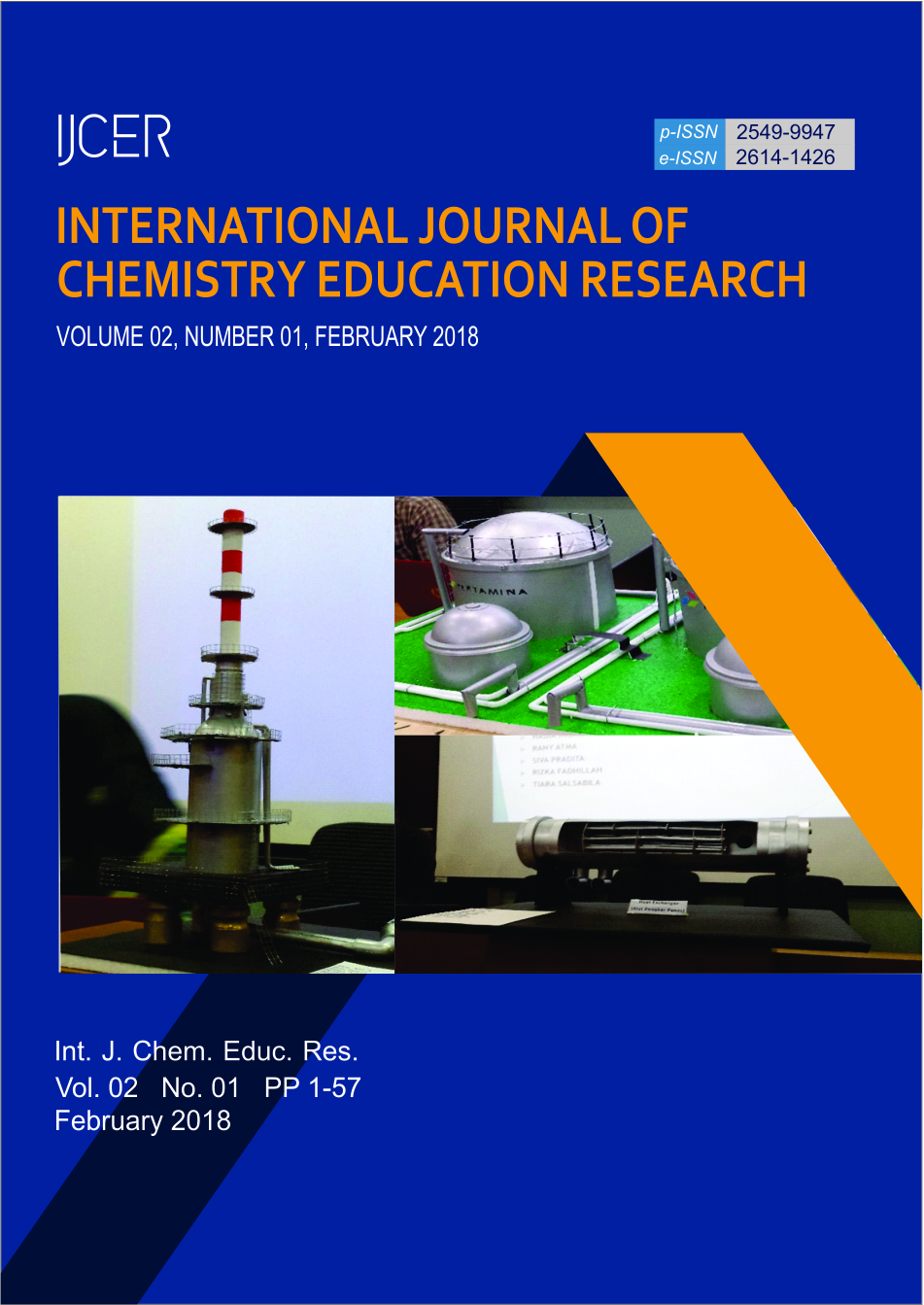Main Article Content
Abstract
ABSTRACT: The aim of this research in to know microscopic representation change in atom and molecule concept which is influenced by STEM Education. This research is one of the sequences in Research and Development of test instrument by chemistry software. The kind of this research is fieldwork research with one group pre-test and post-test design. Subjects in this research are the twenty-seven students in MBS Senior High School grade 11 th in Yogyakarta region. STEM Education can improve student microscopic representation skill from 30.18 to 54.62 in average score and based on student result in painting molecule with ChemDraw and Avogadro's application, there are a lot of improvement in understanding concept.
Keywords: STEM education, microscopics representations, atom and molecule
Received: 11 January 2018, Revised: 21 January 2018, Accepted: 24 February 2018
Article Details
Author retain copyright and grant the journal right of first publication with the simultaneously licenced under A Creative Commons Attribution (CC-By-SA) 4.0 License that allows others to share the work with an acknowledgment of the worsk's authorship and initial publication in this journal.
References
- C. D. Denson, C. Hailey, C. A. Stallworth and D. L. Householder, Int. J. STEM. Educ, 16, 1 , 11 -15 (2015).
- C. C. Meng, N. Idris, and L. K. Eu. EURASIA, J. Math. Sci. Tech. Ed. 10, 3, 219-227 (2014).
- N. Koga. A multidisiplinary and Comprehansive Chemistry Teaching or Learning for Next Generation.
- In: Proceeding of ISCE (The first of International Seminar on Chemical Education 2015 UII, Yogyakarta, 2015).
- E. Trnove and J. Trna, Procedia: Sosial and Behavioral Science, 167, 184-189 (2015).
- N. D. A. Halim, M. B. Ali, N. Yahaya and M, N, H. M. Said, Procedia: Sosial and Behavioral Science Proceeding, 97, 224-228 (2013).
- A. G. Horrison and R. K. Coll, Analogi dalam Kelas Sains (Panduan FAR-Cara Menarik untuk Mengajar dengan Menggunakan Analogi) Translated by Akhlis Nursetiadi (PT Indeks, Jakarta, 2013).
- S. Ceylan and Z. Ozdilek, Procedia: Sosial and Behavioral Science, 177, 223-228 (2015).
- I. Eilks, T. Witteck, and V. Pietzner, C.E.P.S. J. 2, 1, 125-145 (2012).
- D. F. Treagust, G. Chittleborough and T. L. Mamiala, Int. J. Sci. Educ. 25,11 , 1 353-1369 (2003).
- N. D. A. Halim, M. B. Ali, N. Yahaya and M. N. H. M. Said, Procedia: Sosial and Behavioral Science Prooceding, 97, 224-228 (2013).
References
C. D. Denson, C. Hailey, C. A. Stallworth and D. L. Householder, Int. J. STEM. Educ, 16, 1 , 11 -15 (2015).
C. C. Meng, N. Idris, and L. K. Eu. EURASIA, J. Math. Sci. Tech. Ed. 10, 3, 219-227 (2014).
N. Koga. A multidisiplinary and Comprehansive Chemistry Teaching or Learning for Next Generation.
In: Proceeding of ISCE (The first of International Seminar on Chemical Education 2015 UII, Yogyakarta, 2015).
E. Trnove and J. Trna, Procedia: Sosial and Behavioral Science, 167, 184-189 (2015).
N. D. A. Halim, M. B. Ali, N. Yahaya and M, N, H. M. Said, Procedia: Sosial and Behavioral Science Proceeding, 97, 224-228 (2013).
A. G. Horrison and R. K. Coll, Analogi dalam Kelas Sains (Panduan FAR-Cara Menarik untuk Mengajar dengan Menggunakan Analogi) Translated by Akhlis Nursetiadi (PT Indeks, Jakarta, 2013).
S. Ceylan and Z. Ozdilek, Procedia: Sosial and Behavioral Science, 177, 223-228 (2015).
I. Eilks, T. Witteck, and V. Pietzner, C.E.P.S. J. 2, 1, 125-145 (2012).
D. F. Treagust, G. Chittleborough and T. L. Mamiala, Int. J. Sci. Educ. 25,11 , 1 353-1369 (2003).
N. D. A. Halim, M. B. Ali, N. Yahaya and M. N. H. M. Said, Procedia: Sosial and Behavioral Science Prooceding, 97, 224-228 (2013).




